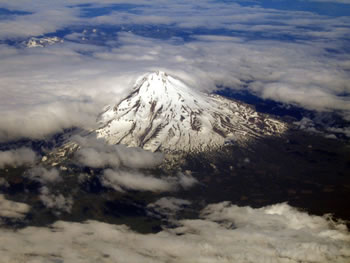
Quotations Links Bibliography Notes Earth Sitting Photographs
Walking One Old Druid's Final Journey Cloud Hands Blog

Photo by F. Jackson, WikiTierra
Mount Shasta is a 14,179 foot (4,322 m) stratovolcano. It is the second highest peak in the Casade Range, and the fifth highest peak in California. It is a member of the Cascade Volcanic Arc. It is located in Siskiyou County, California, in the United States of America. It is considered to be one of the Sacred Mountains on Mother Earth.
Geological Facts about Mt. Shasta
Mount Shasta is 14,179 feet (4,322 m) high.
It is a stratovolcano.
It has an estimated volume of 108 cubic miles (450 km³), making it the
most voluminous stratovolcano of the Cascade Range.
It
is the second highest peak in the Casade Mountain Range, the highest being
Mt. Ranier, Washington,
14,410 feet (4,392 m).
It is the fifth highest peak in California, the highest being
Mt. Whitney 14,505 feet
(4,421 m).
It is part of the
Cascade Volcanic Arc, a range of volcanoes from Northern California to
Southern Canada.
It is located in Siskiyou County, California, United States of America, North
America, World.
It has one of the largest base-to-summit rises of the world's mountains, from
10,000 to 11,000 feet above the surrounding area.
It one of the great singular mountains, rising alone from the surrounding
countryside, unconnected to other mountain peaks, like
Mt. Fuji in Japan (12,388',
3,776m) a stratovolcano, and
Mt. Kilmanjaro in
Africa (19,340', 5,875m) a stratovolcano.
It has a sattelite cone, Shastina, 12,330 feet (3,758 m) to the west of
the main peak.
There are seven named
glaciers on
Shasta, with the four largest (Whitney,
Bolam,
Hotlum, and
Wintun) radiating down the from high on the main summit cone to below 10,000
ft (3,000 m) primarily on the north and east sides.
Experts estimate that the last eruption on Mt. Shasta was in 1800 CE.
In the Karuk Indian People's name for Mt.
Shasta for Mr. Shasta was Úytaahkoo. They also referred to
the mountain as Tuiship ada (mountain with snow) or Oou tuko Tueship
(snow hitting the mountain].
The Ajumawi Pit River Indian People's name for Mt. Shasta was Ako-Yet or Yet-acu.
The Shasta Indian People's name for Mt. Shasta was Waka-nunee-Tuki-wuki.
The Wintu Indian People's name for Mt. Shasta was Bohem Puyuik.

Mt. Shasta
Bibliography, Links, Resources
Ascension Secrets, Alchemy, Teachings and Techniques from the Acended Master Saint Germain
The Best Easy Day Hikes for Redding, California. By Montana Hodges.
Guilford, Connecticut, Falcon Guides, 2010. 117 pages. ISBN:
9780762752546. VSCL.
The
Best Short Hikes in and around the North Sacramento Valley. By John R.
Soares.
Seattle, Washington, 1992. Index, 190 pages. ISBN:
089886318X. VSCL.
Camping on Mt. Shasta: McBride Springs, Panther Meadows
Cloud Hands
Blog by Mike Garofalo
The
Complete Walker III: The Joys and Techniques of Hiking and Backpacking.
By Colin Fletcher. Illustrations by Vanna Prince. Third Edition, Revised,
Enlarged and Updated. New York, Alfred A. Knopf, 1968, 1984. Index, 668 pages. ISBN:
0394519620. VSCL.
The
Dayhiker's Handbook: An All-Terrain, All-Season Guide. By John
Long and Michael Hodgson. Camden, Maine, Ragged Mountain Press, 1996. Index, appencices, 216 pages. ISBN: 0070291462. An excellent
guide to preparing for and enjoying long day walks in the desert, mountains, jungles, canyons and streams, in the forest and along the coast. Practical tips and useful
advice. VSCL.
Fowler's Campground at McCloud Falls
Geology
of the Mt. Shasta Region by Professor William Hirt
Imagine, Ritual Spaces, Mt. Shasta
Lake Siskiyou - Reynold's
Resort
Lassen
Volcanic National Park and Vicinity. By Jeffrey P. Schaffer. A
natural history guide to Lassen Volcanic National Park, Caribou Wilderness,
Thousand Lakes Wilderness, Hat Creek Valley, and McArthur-Burney Falls State
Park. Berkeley, California, Wilderness Press, 3rd Edition, 2003.
Index, 223 pages. Includes map. ISBN: 0899973299. VSCL.
Meditation Walks Around Mt. Shasta
Mindful
Hiker: On the Trail to Find the Path. By Stephen Altschuler.
DeVorss Publishing, 2004.
180 pages. ISBN: 0875167977.
The Mt. Shasta Book: A Guide to Hiking, Climbing, Skiing and Exploring the Mountain
and Surrounding Area
By Andy Selters and Michael
Zanger. 3rd Edition. Berkeley, California, Wilderness Press, 1989,
2006. Index, resources, 175 pages. ISBN: 089997404X. VSCL.
Mt. Shasta: An Annotated
Bibliography. By William C. Miesse. Materials described in
Mount Shasta: An Annotated Bibliography by William C. Miesse are located in
the College of the Siskiyous Library
Mount Shasta
Collection. The following sections contain textual information. Search the
online bibliography.
Mt.
Shasta: California's Mystic Mountain. By Emilie A. Frank.
Klamath River, CA, Living Gold Press, 1998, 2006. Bibliography, 210 pages. ISBN: 1888740086. VSCL.
Mt. Shasta Chamber of Commerce
Mt. Shasta
Collection, College of the Siskiyous Library, California The Mount
Shasta Collection is the largest repository of information and documents about
Mount Shasta. The collection consists of thousands of books, articles,
manuscripts, photographs, maps, prints, and audiovisual materials about the
Mount Shasta volcano and surrounding area. These materials are available at the
College of the Siskiyous Library. As part of an ongoing project, documents from
the collection will be made available here.
Mt. Shasta Fact Sheet, College of the Siskiyou's Written by
William Miesse. 4 pages. 2005
Mt. Shasta Fact Sheet with References, College of the Siskiyou's.
Written by William Miesse. 34 pages.
Mt.
Shasta: History, Legend and Lore. By Michael Zanger. Berkeley,
CA, Celestial
Arts, 1992. References, 120 pages. ISBN: 0890876746. VSCL.
Walking Quotations 1 Walking Quotations 2 Walking Quotations 3 Walking Quotations 4 Walking Quotations 5
Walking Quotations 6 Walking Meditation Ways of Walking Website Cloud Hands Blog
Mt. Shasta Magazine: New Age,
Spirituality
Muir, John (1838-1914)
Articles by John
Muir about Mt. Shasta
Native American
Interviews Regarding Mt. Shasta, 1991. By Dorothea J. Theodoratus and
Nancy H. Evans.
On Assignment with Adama: Mt. Shasta, Telos, Lemuria, and Sacred Earth Sites,
Book I. By Susan Isabelle.
Author House, 2005. 296 pages. ISBN: 1420842781.
Origin of the Name
"Mt. Shasta"
Photo Gallery for Mount
Shasta
Places to Visit in the
Mt. Shasta Area The Sacred Center of Mt. Shasta.
The Sacred Center of Mt. Shasta
Secrets
from Mt. Shasta. By Earlyne C. Chaney. Astara, 1953.
77 pages. ISBN: 0918936101.
75
Hikes in California's Lassen Park and Mount Shasta Regions. By John R.
Soares. Seattle, Washington, The Mountaineers, 1996. Index, 206 pages. ISBN:
0898864666. VSCL.
Shasta Abbey Buddhist Monastery
Shasta Trinity National Forest
Homepage
Shasta Vortex Adventures.
Tours, Retreats, Adventures. Organized by Ashalyn.
Soul Connections. A
Golden Age Emporium.
Spiritual Retreats - Mt. Shasta
The
Trinity Alps: A Hiking and Backpacking Guide. By Luther Linkhart with
Michael White. Berkeley, California, Wilderness Press, 3rd Edition, 1994.
ISBN: 0899971768. Index, 228 pages. Includes topographic map. VSCL.
Valley Spirit Center, Red
Bluff, California
VSCL = Valley Spirit Center Library. Home library of Mike and Karen
Garofalo.
Walking: Bibliography,
Links, Quotations. By Mike Garofalo.
Walking Meditation. By Mike Garofalo.
Wesak
Celebration, Early May, Mt. Shasta
Where
the Lightning Strikes: The Lives of American Indian Sacred Places. By
Peter Nabokov. New York, Viking, 2006. Index, bibliography, 250
pages. ISBN: 0670034320. Includes discussion of California sacred
places such as Mt. Diablo and Mt. Tamalpais near San Francisco Bay, Yosemite,
and Mt. Shasta and Klamatha/Trinity Rivers (pp.264-300).
Wilderness Basics: The Complete Handbook for Hikers and Backpackers.
By the San Diego Chapter of the Sierra Club. Edited by Jerry Schad and
David S. Moser. Seattle, The Mountaineers, 2nd Edition, 1993. Index,
224 pages. ISBN: 0898863481. VSCLC.

Mt. Shasta
and Mountains
Quotations: Facts, Lore, Poetry, Information, Legends
"When I first caught sight of Mt. Shasta, over the braided folds
of the Sacramento Valley, I was fifty miles away and afoot, alone and weary.
Yet all my blood turned to wine, and I have not been weary since."
- John Muir, 1874
"In the last few decades Mount Shasta has become known locally as one of the
‘Seven Sacred Mountains of the World,’ however there is no officially recognized
world list of seven sacred mountains and regional lists of sacred mountains (of
the Navaho people or of China, for example) do not include Shasta. Nonetheless
Shasta as a sacred mountain does have a well established and widespread legacy.
To generations of Native Americans the mountain was and is a highly important
place of reverence and a place of balance between earth and universe. To early
Californian explorers, climbers, and settlers it was a source of awe and
inspiration. To travel writers of the late 1800’s it was “The Keystone of
California Scenery” and “California’s Fuji-san.” But it was in the early
20th century that three books firmly established Shasta’s reputation as a most
unusual and sacred mountain. These three books, A Dweller on Two Planets,
Lemuria, and Unveiled Mysteries, gave Shasta a body of myth
and legend that is perhaps unrivaled in all of North American mountain
literature."
- William Meisse,
Mt. Shasta Fact Sheet, 2005
"Mount Shasta, a 14,179-foot (4,322 m)[1]
stratovolcano, is the second-highest peak in the
Cascade Range and the
fifth highest peak in
California.
It is a member in the
Cascade Volcanic Arc and is located in
Siskiyou County, and has an estimated volume of 108 cubic miles (450 km³),
making it the most voluminous stratovolcano of the Cascades.[5]
Physically unconnected to any nearby mountain, and rising abruptly from miles of
level ground which encircle it, Mount Shasta stands some 10,000 feet (3,000 m)
above the surrounding area.
- Mt. Shasta,
Wikipedia
Great Altar above the Sacramento Valley
White Pyramid below the Winter Moon
Grey-black Stratovolcano shimmering in the Summer Sun
Lonely as Olympus on the New Moon
Surrounded by the bowing Black Forests of NorCalifia
- Mike Garofalo, Genus loci Giganticus
"And well this Golden State shall thrive, if like its own Mount Shasta, sovereign law shall lift itself in pure atmosphere - so high." -- John Rollin Ridge, 1854
"The Mount Shasta Region has been a
destination for relaxation and rejuvenation since the late 1800's with its
pristine glacial waters, natural mineral springs, pure mountain air and
unsurpassed alpine scenery. Mount Shasta, at 14,612 feet elevation, is
internationally recognized as a sacred energy vortex. It attracts thousands of
people year-round for personal and group retreats and workshops, spiritual
pilgrimages, vision quests, healing and such. The many indigenous Native
Americans that once lived around the mountain have always considered Mount
Shasta to be sacred ground, especially above tree line. Even today, they
continue their sacred ceremonies there."
- Shasta Vortex
Adventures
"Our way is not soft grass,
it's a mountain path with lots of rocks.
But it goes upward, forward, toward the sun."
- Ruth Westheimer
"Mount Shasta - a vision of immensity such as pertains to the
vast universe rather than to our own planet."
- James Dwight Dana, 1849
"I first met
Chang San-Feng above the forest,
near the clear spring,
when gathering clouds darkened the day,
and Mt. Shasta was silent.
His long beard was black as
emptiness,
ear lobes to his shoulders,
holding obsidian in his hand,
pointing to the sun,
eyes staring into infinity,
his long body clothed in silence.
We exchanged "hellos"
smiled and bowed,
a barbarian and an Immortal,
both panting from the climb,
laughing,
ten-thousand echoes
between our rocky minds.
After billions upon billions of
heartbeats past
(for he must have been 888 years old),
I was so bold
as to ask the ancient one
for the sacred mantra of yore.
He lifted his whisk,
and brushed my face,
I could not speak,
my lips were stone,
ideas stopped -
I was alone."
- Michael P. Garofalo,
Meetings with Master
Chang San-Feng
Walking Quotations 1 Walking Quotations 2 Walking Quotations 3 Walking Quotations 4 Walking Quotations 5
Walking Quotations 6 Walking Meditation Ways of Walking Website Cloud Hands Blog
"Climb the mountains and get their
good tidings. Nature's peace will flow into you as sunshine flows into trees. The winds will blow their freshness into you, and the storms their energy, while cares will drop off like falling leaves."
- John Muir
"As lone as God and white as a winter moon,
Mount Shasta starts up suddenly from the heart of the great black forests of
California. You would hardly call Mount Shasta a part of the Sierras; you
would say rather that it is the great white tower of some ancient and eternal
wall, with here and there the white walls overthrown. It has no rival!
There is not even a snow crowned subject in sight of its dominion. A shining
pyramid in everlasting mail of frosts and ice, the sailor sometimes, in a day of
singular clearness, catches glimpses of it from the sea a hundred miles away to
the west; and it may be seen from the dome of the capitol 340 miles distant. The
immigrant coming from the east beholds the snowy, solitary pillar from afar out
on the arid sage-brush plains, and lifts his hands in silence as if in answer to
a sign."
- Joaquin Miller, Life Amongst The Modocs, 1874
"My father considered a walk among the
mountains as the equivalent of churchgoing."
- Aldous Huxley
"Mount Shasta (Karuk:
Úytaahkoo or "White Mountain"
[5] :
the origin of the name "Shasta"
is vague, perhaps from
Russian (Чистая, means "white, clean, pure" or Счастье, means
"happiness, luck, fortune, felicity") from the early
Russian settlers in California) is located at the southern end of the
Cascade Range in
Siskiyou County,
California
and at 14,179 feet (4,322 m)[1]
is the second highest peak in the Cascades and the
fifth highest in
California.
The mountain and its surrounding area are managed by the U.S. Forest Service,
Shasta-Trinity National Forest."
- Mt. Shasta -
Wikipedia
"Farewell we call to hearth and hall!
Though wind may blow and rain may fall.
We must away ere the break of day.
Far over wood and mountain tall."
- J.R.R. Tolkien, Lord of the Rings
"Land of the
turquoise sky
Eight thousand feet above worry level.
Where the planets shine brightest
On the fringe of the covering snow.
Where the pine grouse sounds his drum
And the Clark's crow feeds his young.
Where the soaring eagle scanning wide
And the frisky chipmunk seeks to hide.
The hunted stag finds his well earned rest
And the eager mountaineer seeks his quest.
This is where I wish to go
To the land of the lasting ice and snow."
- Chief Yola Wintu
"Ode to the Shasta Alpine Lodge"
Mount Shasta Herald, July 21, 1927, p.7
"In the evening, I walked alone down to the
Lake by the side of Crow Park after sunset and saw the solemn coloring of night
draw on, the last gleam of sunshine fading away on the hilltops, the seep serene
of the asters, and the long shadows of the mountains thrown across them, till
they nearly touched the hithermost shore. At distance hear the murmur of
many waterfalls not audible in the day-time. Wished for the moon, but she
was dark to me and silent, hid in her vacant interlunar cave."
- Thomas Gray, Journal in the Lakes
"Mount Shasta is legendary as
one of the homes of the Ascended Masters where saints & angelic beings have
revealed themselves over the centuries. Ancient legends of Mount Shasta reveal
this holy site as where ancient ones lived in heaven on earth as they did in
Asgard and Mount Olympus. Ascended Master Saint Germain's energy continuously
radiates from the Temple of the Violet Flame deep in the inner recesses of the
mountain. Many people all over the world see these mysterious lights and glowing
energy emissions from this sacred mountain. Many believe other Masters
influence the energy of this area and are making this their headquarters during
the Age of Aquarius that brings peace, love, abundance and wisdom. It is
believed that Mount Shasta embodies the head of a huge geographical etheric
energy grid. This sacred mountain has given many people centuries of
access to its energy centers. The pristine meadows, graceful slopes and
isolated beauty of the mountain continue to provide a haven for those who seek
sanctuary from the world that lies at its feet."
- Dr. Susan
Shumsky
"From thought to thought, from mountain
peak to mountain.
Love leads me on; for I can never still
My trouble on the world's well beaten ways."
- Petrarch, Ode 17
"To lord all Godland! lift the brow
Familiar to the moon, to top
The universal world, to prop
The hollow heavens up, to vow
Stern constancy with stars, to keep
Eternal watch while eons sleep;
To tower proudly up and touch
God's purple garment-hems that sweep
The cold blue north! Oh this were much!
Where storm born shadows hide and hunt
I knew thee, in thy glorious youth,
And loved thy vast face, white as truth;
I stood where thunderbolts were wont
To smite thy Titan-fashioned front,
And heard dark mountains rock and roll,
I saw the lightning's gleaming rod
Reach forth and write on heaven's scroll
The awful autograph of God."
- Joaquin Miller
"Mount Shasta"
From Shadows of Shasta, Jansen/McClurg, 1881, p. 17
"The silence of landscape conceals vast
presence. Place is not simply location. A place is a profound individuality.
With complete attention, landscape celebrates the liturgy of the seasons, giving
itself unreservedly to the passion of the goddess. The shape of a landscape is
an ancient and silent form of consciousness. Mountains are huge contemplatives.
Rivers and streams offer voice; they are the tears of the earth's joy and
despair. The earth is full of soul ….. Civilization has tamed place. Left to
itself, the curvature of the landscape invites presence and the loyalty of
stillness."
- John O'Donohue, Anam Cara
"Once in a lifetime, perhaps, one escapes
the actual confines of the flesh. Once in a lifetime, if one is lucky, one so
merges with sunlight and air and running water that whole eons, the eons that
mountains and deserts know, might pass in a single afternoon without
discomfort."
- Loren Eisley, The Immense Journey
"The north side of Mt. Shasta has been inhabited since at least 600 BC,
possibly 2500 BC. Artifacts in the greater area suggest 9,000 years of Native
American habitation. Mt. Shasta was a corner territorial boundary for four
Native American peoples - the Shasta,
Modoc, Ajumawi/Atsuwegi, and Wintu - and within the view of the Karuk Tribe on
the mid-Klamath River and the Klamath Tribe of the upper Klamath River.
For all these native peoples, Mt. Shasta was the
center of creation. The
Shasta people believed that the Great
Spirit first created the mountain, by pushing down ice and snow through a hole
from heaven, then using the mountain to step onto the earth. He created trees
and called upon the sun to melt snow to provide rivers and streams. He breathed
on the leaves of the trees and created birds to nest in their branches. He broke
up small twigs and cast them into streams, where they became fish; branches cast
into the forest became animals. The nearby
Modoc people shared this creation account and taught that the Great
Spirit lived on Mt. Shasta after creation. His daughter fell from the mountain
and was raised by grizzly bears. She married one of their clan, and their
children were the first humans. In punishment, the Great Spirit condemned the
bear to walk on four legs and scattered their children all over the world.
Today, descendents of these Native American tribes still live in the area and
carry out ancient rituals in honor of the mountain. Each year, the Wintu invoke
the mountain's spirit with ritual dances that ensure the continued flow of the
sacred springs."
- Sacred
Destintations - Mt. Shasta
“The heights charm us, but the
steps do not; with the mountain in our view we love to walk the plains.”
- Johann Wolfgang von Goethe
"There’s all sorts of walking—from heading out across
the desert in a straight line to a sinuous weaving through undergrowth.
Descending rocky ridges and talus slopes is a specialty in itself. It is an
irregular dancing—always shifting—step of walk on slabs and scree. The breath
and eye are always following this uneven rhythm. It is never paced or clocklike,
but flexing—little jumps—sidestep—going for the well-seen place to put a foot on
a rock, hit flat, move on—zigzagging along and all deliberate. The alert eye
looking ahead, picking the footholds to come, while never missing the step of
the moment. The body-mind is so at one with this rough world that it makes these
moves effortlessly once it has had a bit of practice. The mountain keeps up with
the mountain … The landscape can become both ritual and meditation."
- Gary Snyder
"The tendency nowadays to wander in
wilderness is delightful to see. Thousands of tired, nerve-shaken,
over-civilized people are beginning to find out that going to the mountains is
going home; that wildness is a necessity; and that mountain parks and
reservations are useful not only as fountains of timber and irrigating rivers,
but as fountains of life.
- John Muir, Our National Parks
The Shasta Indian name for Mt. Shasta, Waka-nunee-Tuki-wuki, is the
same as the name for the Shasta Creator. This name, meaning to "walk around and
around, but never on top," should be repeated twice anytime the mountain comes
into a Shasta person's vision. The area above the tree line on Shasta has been
reserved for the "Gods," and therefore, is not a place a Shasta person would
travel except under special circumstances. Shasta was the first place Waka
stopped after creating the Shasta world. Certain springs on the mountain are
Waka's footprints, and other topographical features were created through Waka's
actions. Besides a creation area, Mt. Shasta is the site of other historic
activities also referred to in other Shasta mythology. Traditionally, if a
Shasta person desired purification, he or she might walk clockwise around the
mountain, beginning at a cave on the northwest side. A person would travel
about one-half a day at a time, below the tree-line, returning to the starting
point at the cave. A traveler would stay by a creek or spring during the trek.
After walking the full circumference, one could go above the tree-line which is
considered to be a place to die."
- Dorothea J.
Theodoratus and Nancy H. Evans
"May your trails be crooked, winding, lonesome, dangerous, leading to the most amazing view. May your mountains rise into and above the clouds."
"When you walk in the mountains stands of
cedar, among the wise old elder trees, anything you want to know you can find
there."
- Saying of the Lummi Tribe of Puget Sound

Mt. Shasta
Notes, Observations, Comments by Mike Garofalo
Summer 2012
8/10/2012 Climbed from Bunny Flat (6,950')to Horse Camp Sierra Hut (8,000') on Mt. Shasta. Listened to Indian drumming at 8 am. A hazy and hot day. Afterwards, I spent some time shopping in a Mt. Shasta occult and New Age store. Very tired today.
Summer 2010-2011
Numerous trips to areas south of Mt. Shasta. Numerous trips through the area on the way to and from Oregon. Took numerous visitors up to the mountain. Enjoyed numerous trips to McCloud Falls with family and friends.
July 2009
Climbed Grey Butte and hiked on south side of Shasta. Numerous trips through the area on the way to and from Oregon. Extensive touring in area south of Mr. Shasta.
Our Chrysler minivan broke down near McCloud, and we spent three days in Mt. Shasta City.
August 2008
Two trips up to the McCloud River Falls area, Burney Falls, and south side of Shasta. Numerous trips through the area on the way to and from Oregon.
June 29, 2007, Friday
Karen and I spent some time on The Mountain and in Mt. Shasta City today. We enjoyed visiting the the spring at the Mt. Shasta City Park that is called the "headwaters of the Sacramento River." Many children were using the park for a children's summer camp program. A group of 10 adults were gathered in a circle in a far corner of the lawn of the park and were involved with a pagan ritual and shaking rattles. The spring in this park gushes out of the side of The Mountain (Mt. Shasta) and into this densely forested park. Hundreds of creeks and streams drain from the surrounding mountains down the canyons into the Sacramento River, flowing south to Sacramento, and then west into San Francisco Bay.
We drove up above Panther Meadows to the end of Everett Highway. We spent some time at the picnic area enjoying the views to the south. Today, we enjoyed very comfortable temperatures in the mid 60's. There was very little snow this year on Mt. Shasta.
Numerous trips through the area on the way to and from Oregon.
Since 2007, we have explored the Mt. Shasta, Dunsmuir, Yreka, McCloud, and Weed areas many many times. We have driven all the paved roads in the area: Interstate 5, Cal 3, Cal 139, Cal 89, Cal 97, Cal 44, Cal 36. We have been to Lake Siskiyou many times. We have hiked on the trails of Mt. Shasta. Since we drive to Portland four or five times each year, we take different driving routes to explore new areas in Oregon and Northern California.
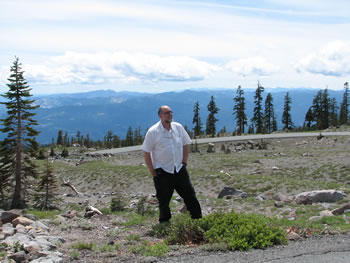
Mike Garofalo, South Side of Mt. Shasta, 8,000 feet
Sacred Mountains of the World
Mt. Kailash in Tibet (21,778', 6,638m), sacred to Buddhism, Hinduism, Jainism, and Bon religions.
Mt. Shasta in California, USA, (14,179', 4,322m) sacred to Native Americans, Neo-Pagans, New Agers.
Mt. Fuji in Japan (12,389', 3776m)
Random Gatherings:
Images of Mt. Shasta
http://www.tierrawiki.org/wiki/Image:Mount_shasta_234324.jpg By F. Jackson.
Photographs of Mt. Shasta
By Mike Garofalo
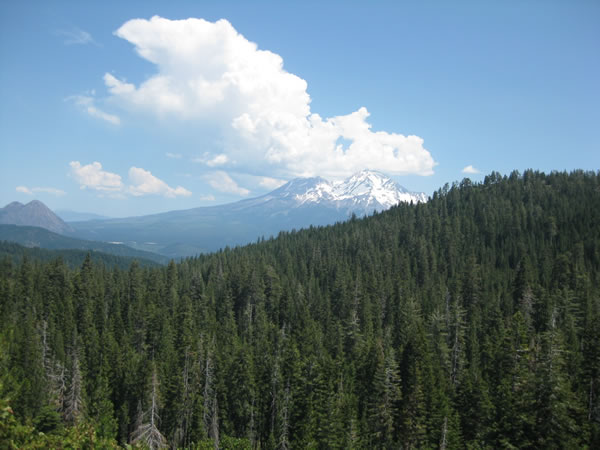
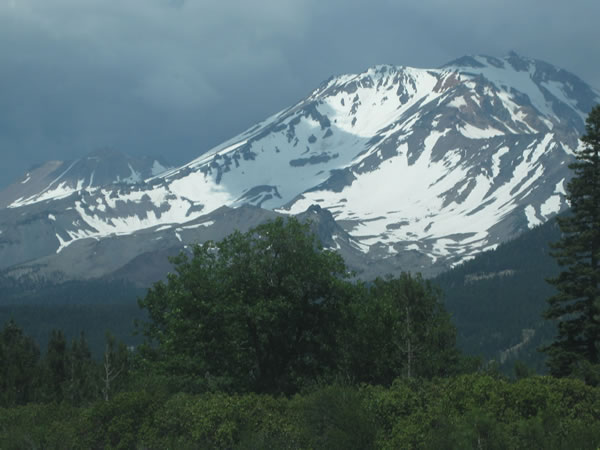
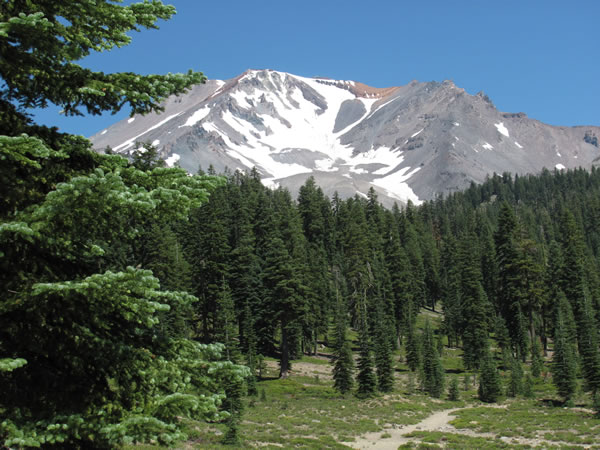
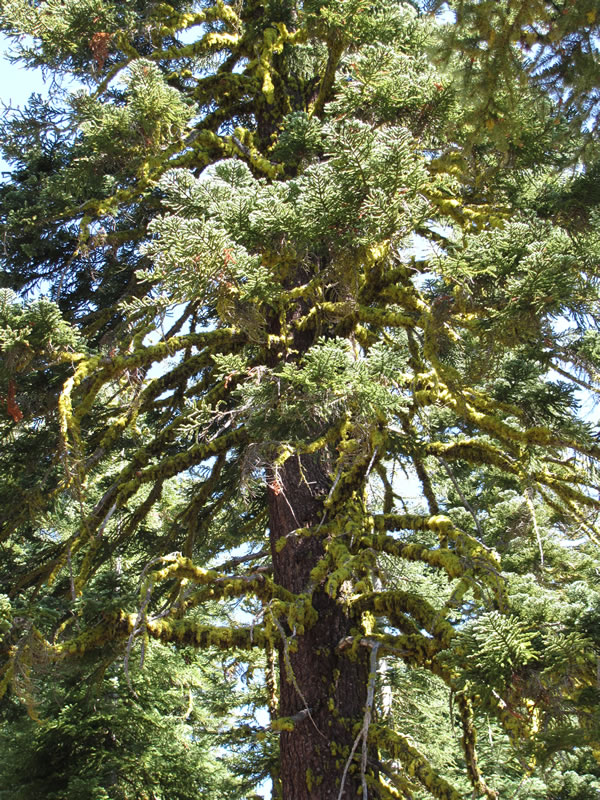
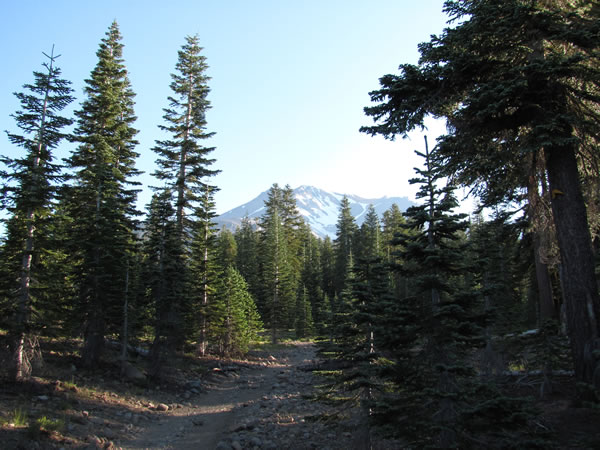
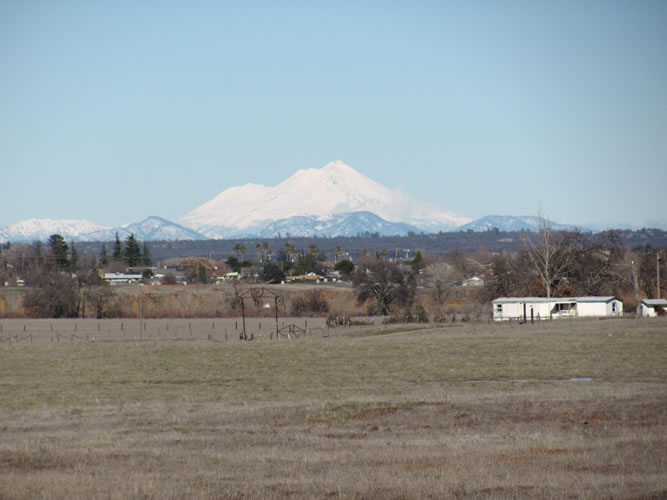
This is a view of Mt. Shasta from Red
Bluff. We live 100 miles south
of Mt. Shasta. Despite the distance, the view is still impressive.
This
photo was taken in January.

© 2007-2015,
Green Way
Research, Valley Spirit Center, Red Bluff, California
Michael P. Garofalo, All Rights Reserved
This webpage was first published on the Internet in July of 2007.
This webpage was last modified or updated on November 11, 2015.
Prior to 8/8/2012 this webpage was located at: http://www.egreenway.com/meditation/shasta.htm.